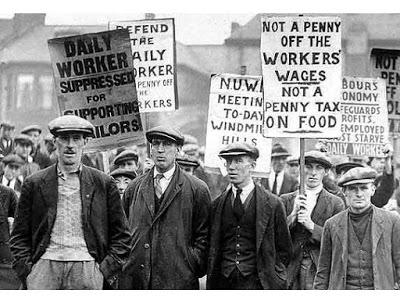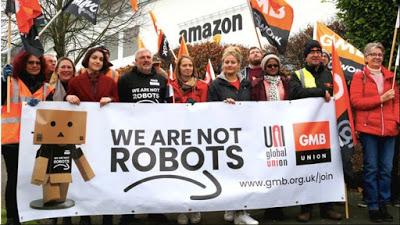

Marx offered several theories of the modern world that he observed around him in mid-nineteenth-century Britain that have influenced much of turmoil that ensued in the following century and a half -- theories about the "capitalist mode of production," about the role that class conflict plays in historical change, about the determinants of the actions of the state. These themes are expressed in Capital, and in the The German Ideology and The Communist Manifesto decades earlier. So one might imagine that these are theoretical constructions of Marx's imagination, a particular way of interpreting the social realities that he observed. The Right blames "Marxism" for discontent among many citizens in western democracies. Marx was a "radical," and his radical vision of conflict and exploitation guided his narrative about the nature of modern capitalist society. Adam Smith had one vision of the emerging modern society, Thomas Carlyle had a different one, and Marx had a yet another. The reason working people are discontent, according to the Right, is that there's too much Marxism around, too many critical theories that provoke conflict.
But is this the right way of thinking about the matter? I don't think so. It puts the poet of modernity first, with imagination and rhetoric, and the concrete social processes and contradictions second. But that gets the story backwards. Ideas, including ideas about social relations among different groups in society, have had a role in historical development in the two-plus centuries of economic development since Mr. Watt turned on his steam engine. But the real history was written by actors and groups, considering and framing their own struggles, and seeking to maintain their footing in a changing world. These actors were often illiterate, poor, and disadvantaged. But they brought their own practical understanding to their situation in the social world; they brought social identities, they brought moral frameworks, and they brought practical skills of action and interaction to their struggles to secure their livelihoods and dignity.
Consider the brief sketches that Charles Tilly offered in 1978 of "collective action" in early modern Britain in From Mobilization to Revolution. Here Tilly has described two "riots" by ordinary villagers in 1765 against the establishment of new "houses of industry" (poorhouses where the poor were compelled to work for food).
The confrontations at Nacton and Saxmundharn acted out pervasive characteristics of eighteenth-century conflicts in Great Britain as a whole. While David Hume and Adam Smith worked out the relevant theories, ordinary Britons fought about who had the right to dispose of land, labor, capital, and commodities. Attacks on poorhouses, concerted resistance to enclosures, food riots, and a number of other common forms of eighteenth-century conflict all stated an implicit two-part theory: that the residents of a local community had a prior right to the resources produced by or contained within that community; that the community as such had a prior obligation to aid its weak and resourceless members. (3)And these protests were not guided by "revolutionaries" in the background; neither were they inarticulate cries of protest against changes they could not understand. Rather, these ordinary villagers recognized well the actions that were being taken against them, and they came forward to resist.
Not that the fighters on either side were mere theorists, simple ideologues, hapless victims of shared delusions. Real interests were in play. The participants saw them more or less clearly. At two centuries' distance, we may find some of their pronouncements quaint, incomprehensible, or hopelessly romantic. In comfortable retrospect, we may question the means they used to forward their interests: scoff at tearing down poorhouses, anger at the use of troops against unarmed crowds. Yet in retrospect we also see that their actions followed a basic, visible logic. The more we learn about eighteenth-century changes in Great Britain, the clearer and more compelling that logic becomes.
The struggle did not simply pit different ways of thinking about the world against each other. Two modes of social organization locked in a battle to the death. The old mode vested power in land and locality. The new mode combined the expansion of capitalist property relations with the rise of the national state. Many other changes flowed from that fateful combination: larger-scale organizations, increasing commercialization, expanded commercialization, the growth of a proletariat, alterations of the very texture of daily life. The new mode won. The world of the moral economy dissolved. But when ordinary eighteenth-century Britons acted collectively at all, usually they acted against one feature or another of this new world. On the whole, they acted in defense of particular features of the moral economy. (4)Tilly's interest in this book is a familiar one that recurs throughout his long career: analyzing the historical details that provide sociological insight into the processes of "mobilization and rebellion" when men and women find themselves in circumstances that are existentially threatening for themselves and their families. And yet, Tilly understood what Marx sometimes did not: that it is not true that "workingmen unite, you have nothing to lose but your chains." In any real historical situation (except perhaps the Warsaw ghetto during the uprising, or with Spartacus in Thrace) the potential rebels always have something to lose; mobilization and rebellion are always risky and costly. Mobilization and rebellion require explanation.
Here Tilly provides a very compact description of Marx's theory of class as Marx works it out in his analysis of the politics of the 1848 revolution in France:
If that is so, we might pay attention to Marx's mode of analysis. Implicitly, Marx divided the entire population into social classes based on their relationships to the prevailing means of production. Explicitly, he identified the major visible actors in the politics of the time with their class bases, offering judgments of their basic interests, conscious aspirations, articulated grievances, and collective readiness for action. Classes act, or fail to act. In general, individuals and institutions act on behalf of particular social classes. (There is an important exception: in analyzing Louis Napoleon's seizure of power, Marx allowed that those who run the state may act, at least for a while, in their own political interest without reference to their class base.) In analyzing readiness to act, Marx attached great importance to the ease and durability of communications within the class, to the visible presence of a class enemy. When Marx's political actors acted, they did so out of common interests, mutual awareness, and internal organization. (13)So, no, Marx did not invent class conflict. Marx was not the inventor of class conflict or the spark who ignited a motivation to find a pathway to fundamental change in the relations of power and property that govern the lives of ordinary people. Rather, he was the John Snow of early capitalism, the scientist who worked out which pump handle was giving rise to the cholera of fundamental inequality. As that timeless philosopher, Bob Dylan, put it, "You don't need a weatherman to know which way the wind blows." Marx was the weatherman, not the weather. E.P. Thompson put the point vividly in The Making of the English Working Class: class was "made" through concrete historical experiences, and conflict was an unavoidable component of this making; link.
Who, then, is the actual author of "class conflict"? The modern world, with its economic relations governed by a system of property guaranteeing various extremes of inequality, and no guarantee that a humane social contract will emerge protecting the life interests of all parties -- this is the circumstance that invented class conflict. There are powerful, pervasive features of our economic system that generate and deepen inequalities. The only check to this process is the organized strength of ordinary men and women, demanding a fair share of social cooperation, and all too often this countervailing force has not been sufficient. Social democracy is a solution (link, link, link, link) -- provision of extensive prerequisites of a decent human life to every individual (education, healthcare, access to a job); full and equal rights of political participation, real equality of opportunity, use of progressive taxation to ensure that everyone benefits from economic cooperation -- and yet social democracy has been unconscionably hard to sustain in western democracies.
And in case anyone thinks that this is just an antiquarian question, relevant to Nacton and Saxmundharn in 1765 but not to Detroit, Atlanta, or Seattle today -- just consider the devastation created by the current pandemic for people all over the country who are on the disadvantaged side of the buffet line: disproportionately without healthcare, disproportionately represented in "frontline" positions in the coronavirus pandemic, disproportionately forced to return to work in unsafe conditions or lose what slender entitlements they currently possess, disproportionately represented in the lists of sick and dying, ... This is class conflict in our contemporary world. And the genuinely important question for Chuck Tilly's successors is this: what kinds of mobilization are possible in 2020 to address the appalling inequalities of power, property, opportunity, and wellbeing our society has created? How can ordinary working people achieve and maintain the social democracy (link) that alone promises to fulfill the compact of the equal freedoms and human fulfillment of all people?
